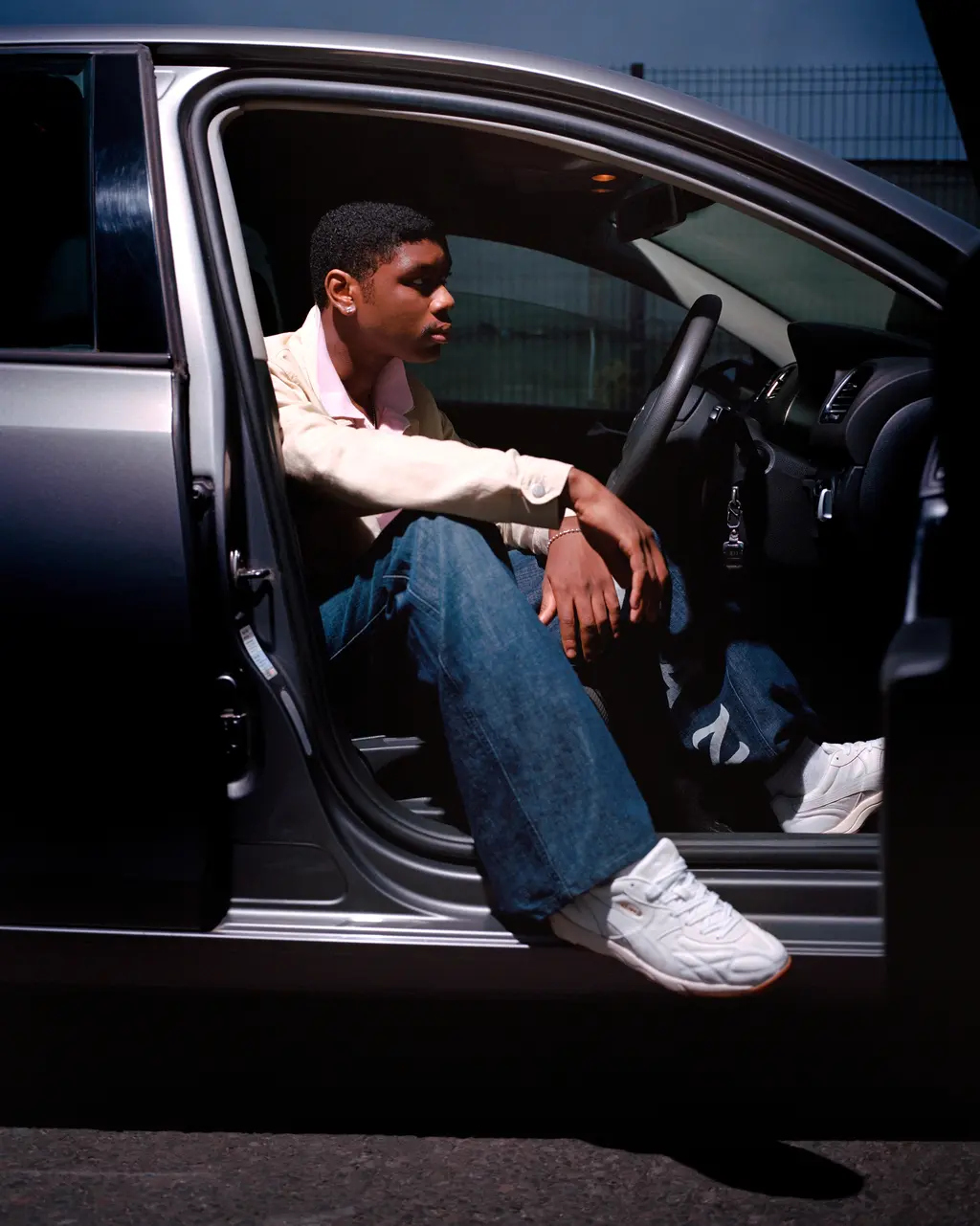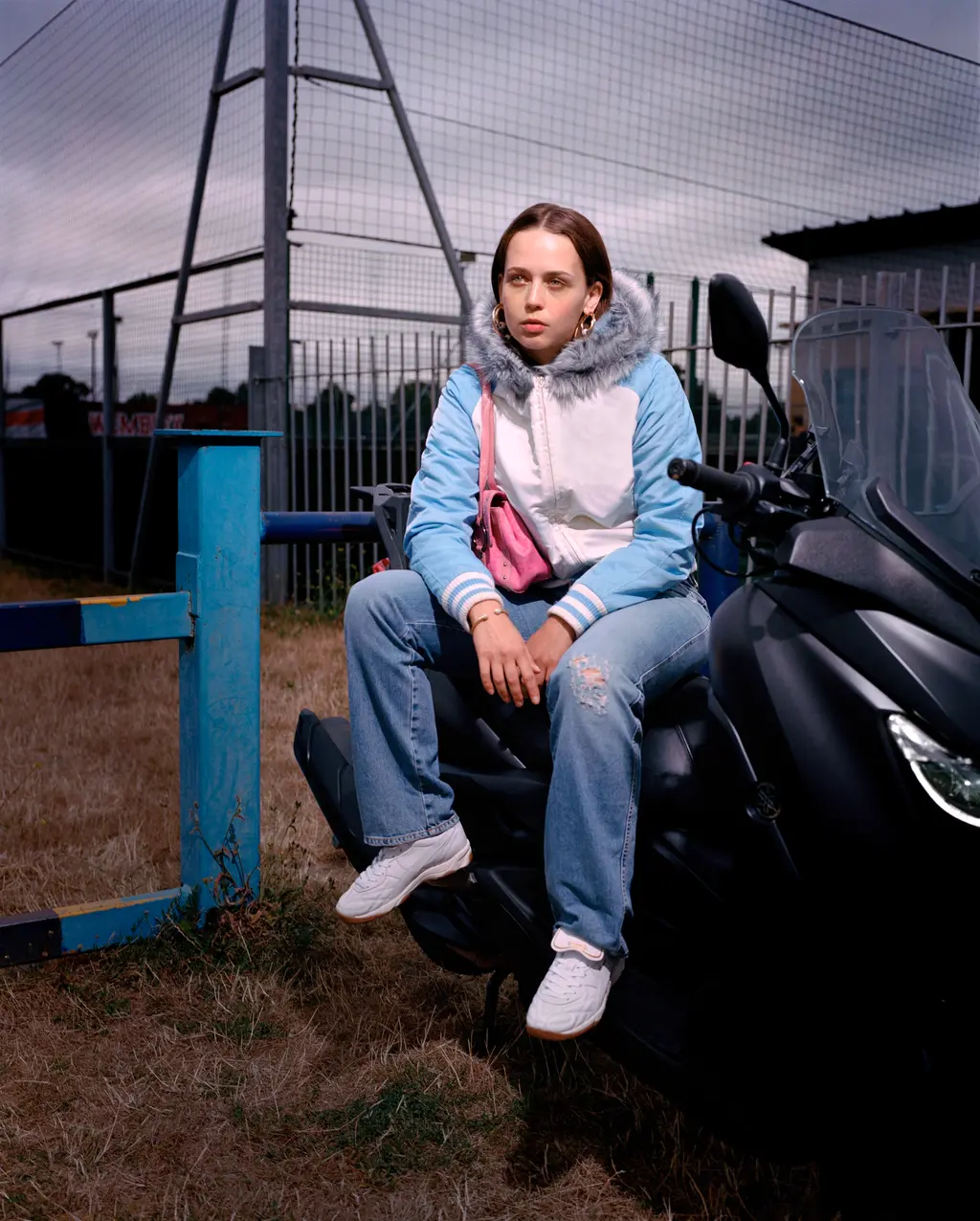A personal ode to an old London

Shot by Ewen Spencer, the new Puma King Indoor campaign riffs on the style and musical subcultures that defined the Big Smoke at the turn of the century. We paid a visit to the stylist behind the shoot, Rhiannon Barry, for a full picture of those good, old days.
Style
Words: Sik Frydas
Photography: Ewen Spencer
Styling: Rhiannon Barry
Rhiannon Barry’s Ninety Fly studio in Peckham is a time capsule. Boxes of archival designer and sportswear spill onto the floor, stacks of Super Super magazine – a seminal, defunct East End publication that documented nu ravers and emerging scenes – balance against the walls, and shelves are lined with relics from the UK’s musical underground. Think: Risky Roadz DVDs, decades-old jungle tape packs and dog-eared copies of THE FACE.
Rhiannon’s journey through London subculture runs deep. She cut her teeth running Wavey Garms with co-owner (and brother) Andres Branco, and since then, has styled everyone from football legend Ronaldinho to UK rap stars like AJ Tracey and D Double E.
Ninety Fly actually predates Wavey Garms, but in recent years, Rhiannon has revived it at Peckham Levels. Her space joins other local institutions such as Wavey Garms and the more grime-focused clothing archive, No License, downstairs.
For her latest project, a Puma King Indoor campaign, Rhiannon tapped into an aesthetic sweet spot between late-90s and early-2000s London, when collared polos, keeper rings, baggy nylon tracksuit jackets and hooped earrings reigned supreme. Raised in southeast London’s Abbey Wood, she knows the look from first-hand experience.
The King’s latest edition comes in a crisp white, with the leather upper and gold “King” embellishments nodding to its football heritage. First launched in 1999 as an off-pitch version of the legendary King football boot, the Indoor quickly became a subcultural staple, equally at home on concrete playgrounds and dingy clubs across the UK and Europe.
Working alongside Slam Jam’s Carlo Tinelli and British photographer Ewen Spencer – famed for documenting UK garage and a nascent grime scene – the campaign captures more than just musical subcultures but also the everyday uniform of old London’s estates: the geeze‑y swagger of Goodbye Charlie Bright (2001), pawn-shop dolly necklaces and that mixture of designer and sportswear that defined British working-class style at the turn of the millennium.
Here, joining Rhiannon for a catch-up in her studio, we unpick some of the reference points and memories that shaped the Puma story, as well as her vision as a stylist and archivist.


This shoot feels quite personal. Did it bring back any specific memories for you?
Going to youth clubs with my friends. I also remember the transition from garage to grime. My aunties and cousins were very much into UK garage, and as I got into year seven or eight, that’s when grime was born. I was going to youth clubs after school almost every day, and there was a recording studio there where everyone would make grime.
How did growing up in Abbey Wood shape your creative outlook?
Abbey Wood was an interesting place to grow up. It’s London – it’s southeast London – but it’s on the borders of Kent. We were quite badly connected compared to the rest of London, and it’s next to Thamesmead. I grew up around a lot of guys playing drum and bass, and my cousins were into jungle. My mum worked full time so we would have to fend for ourselves. Little shits roaming the streets! There were also a few racist pockets around; the BNP [British National Party] head office was down the road.
Was there anything in particular you wanted to accomplish with this campaign?
Everyone’s done the grime kind of styling and the garage with the Moschino prints, and the Avirex-es. But there was a side of it – stuff I collect that I haven’t shown yet – that I wanted to bring through for this campaign. That’s what the Puma King reminds me of. Ewen [Spencer] and Carlo from Slam Jam both really got my vision. It was also what the elders were wearing when I was growing up [in 99/98].
What songs, magazines or little details really remind you of that era?
Channel U and Pure Garage CDs, definitely. There’s a sunbed shop I go to in Isle of Dogs, and the girl who works there is from my area. She smokes outside all day, and she’s always playing Pure Garage. Those CDs were the pinnacle of my upbringing. When that came out, that was all anyone would play. Vans driving past, my aunties, my cousins – even I rinsed it. Super Super magazine, too.
When I moved to Lewisham, I really got into fashion and was trying to be a bit different, but when I was in Abbey Wood, everyone was kind of in a box. If you were a chav, you were a chav; if you were a rudegirl, you were a rudegirl. You couldn’t do anything different, and if you did, you could literally get beaten up for it. Super Super was a big one for me as that was how I would find out about all the cool stuff.
[Nokia] 3310s were a big one as well. Back in the day, you could buy ringtones, and I bought 21 Seconds by So Solid Crew. Every day, there was a queue of people outside my house waiting to copy it onto their phone using the Nokia Composer [a music-making function]. You’d have to individually punch in each note. It literally took 45 minutes to an hour to do the whole ringtone, and if you did one button wrong, it would fuck up the whole thing.
“Sometimes when people send me moodboards of stuff for a shoot, me and my friends will be in it”
Rhiannon Barry, stylist
How did you and Ewen channel your vision for the campaign?
They sent me Ewen’s moodboards, and the ones from Slam Jam, which had a lot of popped collars and those sorts of references. It was really easy, to be honest, I had everything in my collection already.
How do you research for projects like this?
Getting into magazines, watching old-school rave videos… I love researching physically through books. I go down a lot of YouTube rabbit holes too. I watch one video, and the next thing I know, I’m six hours in. That’s what I wanted to create here – in the studio. I wanted it to be really immersive.
How do you decide what to add to your studio’s collection?
Memories. I’ll remember someone wearing something when I was younger and go on an eBay rabbit hole. I do go to car boots and charity shops all the time, but I try to focus on building up and archiving certain areas.
How do you think London’s style and subculture have changed? How do you understand your work archiving it?
It’s always shifting… Garage to grime to funky house to dubstep. I do love to see certain trends coming back, but you lose the subcultures they stemmed from a lot. I was at a car boot sale recently, and this really posh Milly Tilly girl was like, “Oh my gosh, that yellow Avirex!” Back in the day, you needed status to wear certain pieces, and now it’s all so disposable. I try to preserve those eras with what I collect here. Sometimes when people send me moodboards of stuff for a shoot, me and my friends will be in it – or there’ll be looks from the beginning of Wavey Garms. A lot of the early Wavey Garms stuff gets thrown around.
What’s next for you and Ninety Fly? Where do you want to go from here?
One thing I’ve got a little bit lost in is that a lot of my work recently has just been commercial, where I’m just working for and turning over projects for brands. I’ve been thinking about how I want to see my archive styled. I need to do more shoots like this one with Ewen, and more editorials and similar projects where I have more room for creativity. That’s the plan for this year.




